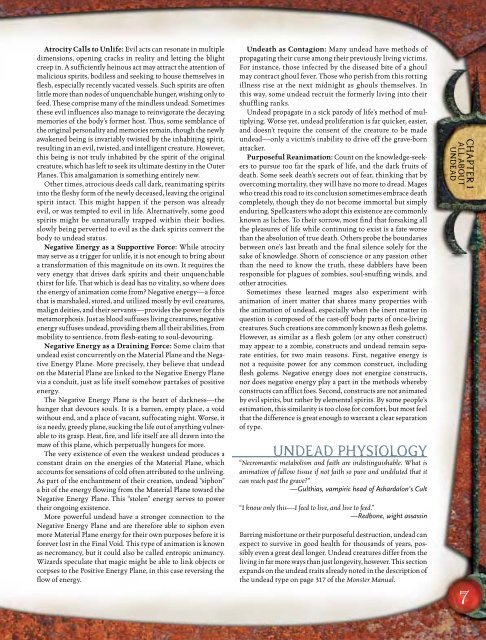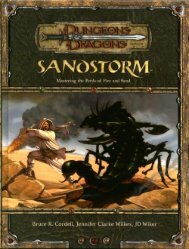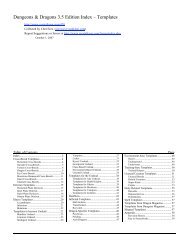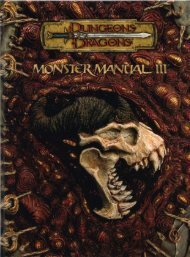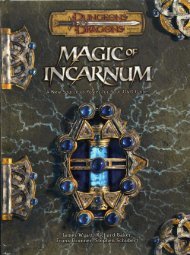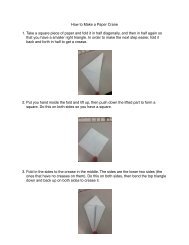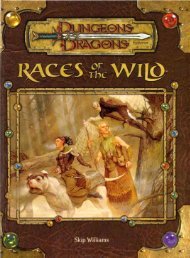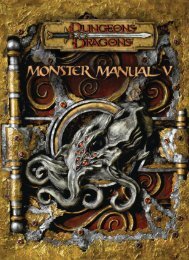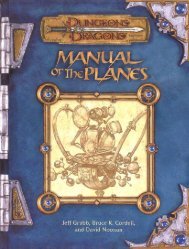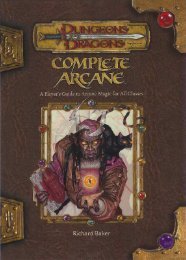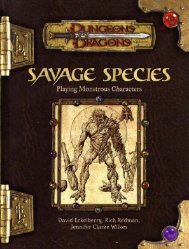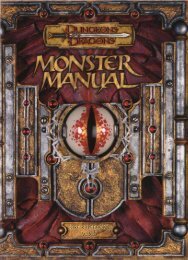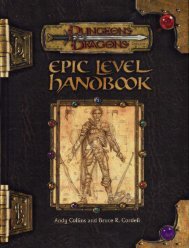pqqqqqqqqqqqqqqqqqqqqrsCHAPTER 1ALL ABOUTUNDEAD6VARIANT RULE: HAUNTING PRESENCESSometimes when undead are created, they come into beingwithout a physical form and are merely presences <strong>of</strong> malignevil. Haunting presences can occur either spontaneously (seeAtrocity Calls to Unlife, earlier in this section) or as a result <strong>of</strong>the spell haunt shift (see page 66). Tied to particular locationsor objects, these beings may reveal their unquiet natures onlyindirectly, at least at first.As a haunting presence, an undead is impossible to affector even directly sense. A haunting presence is more fleetingthan undead that appear as incorporeal ghosts or wraiths, oreven those undead enterprising enough to range the EtherealPlane. In fact, a haunting presence is tied to an object or location,and only upon the destruction <strong>of</strong> the object or locationis it dispelled. However, despite having no physicality, eachhaunting presence still possesses the identity <strong>of</strong> a specifickind <strong>of</strong> undead. For instance, one haunting presence may besimilar to a vampire, while another is more like a wraith.<strong>The</strong> Haunting: Whenever an undead appears as a hauntingpresence, it haunts an unattended, mundane object orlocation. Using the same decision-making process that heuses to populate a location or area with a standard monster,the DM simply chooses an unattended mundane object orlocation as the subject <strong>of</strong> a haunting presence. <strong>The</strong> DM alsodetermines the variety <strong>of</strong> undead (skeleton, zombie, wraith,or other kind) that serves as the source <strong>of</strong> the haunting presence.An undead may haunt a discrete object <strong>of</strong> at least Tinysize and no larger than Huge size. Items (both magical andmundane) currently in the possession <strong>of</strong> a character (<strong>of</strong>tenreferred to as attended items) cannot be haunted. Unattendedmagic items receive a saving throw as if a spell wasbeing cast upon the item (DC 10 + 1/2 the undead’s HD +the undead’s Cha modifier).A haunting presence becomes a part <strong>of</strong> the object or locationhaunted. Haunting presences are always aware <strong>of</strong> whatis going on around the object that they haunt. <strong>The</strong>y can seeand hear up to 60 feet away (but do not gain blindsight). Ahaunting presence cannot be turned, rebuked, or destroyedwhile the presence remains immaterial (but see Exorcisinga Haunting Presence, below). Normal vulnerabilities <strong>of</strong> aparticular kind <strong>of</strong> undead do not apply to the haunting presence<strong>of</strong> that undead. For instance, the haunting presence <strong>of</strong>a vampire haunting a fire poker is not destroyed if broughtinto sunlight.Effects <strong>of</strong> a Haunting: A presence haunting an object maydo so in a couple <strong>of</strong> ways. <strong>Undead</strong> <strong>of</strong> fewer than 5 Hit Dicemay use only one form <strong>of</strong> haunting, but undead <strong>of</strong> 5 or moreHD can make their presence known using either <strong>of</strong> the methodsdescribed below (impermanent home or poltergeist). Nomatter the way the haunting presence makes itself felt, thehaunting presence <strong>of</strong> a sentient undead can always choose tospeak to nearby creatures, usually in a whispery or incoherentvoice that seems to come from the air. However, hauntingpresences are usually not much for conversation. Charactersmay note at times that the object they’ve found or the locationthey inhabit has a strange air, or the appearance <strong>of</strong> it issomehow “<strong>of</strong>f” (with a successful DC 15 Intelligence check).Impermanent Home: An undead presence haunting anobject or an area can sometimes become more than a presence,actually taking corporeal or incorporeal form a number<strong>of</strong> times per week equal to the undead’s Hit Dice (thatincludes haunting presences that manifest “physically” asincorporeal undead). <strong>The</strong> presence that takes form does soanywhere within the location it haunts, or in the closest emptyspace adjacent to the object it haunts. A presence that takesform can remain so for up to a number <strong>of</strong> minutes equal to itsHD. An undead that takes form can always choose to return toits haunting presence status earlier, but it must take a moveaction to do so.While in physical form, the undead can take any actionsnormal for an undead <strong>of</strong> its kind. It can attack, take damage,and even be destroyed. Unless it is a ghost, lich, or some othersort <strong>of</strong> undead that is resistant to destruction, the hauntingpresence is also permanently eradicated, though most attemptto return to their haunting presence status if threatened withsuch destruction.Poltergeist: If an object has parts that move, such as awagon, a clock, or a crossbow, a haunting presence can controlthe object’s movement, though the object will move n<strong>of</strong>aster than the undead itself could move in its normal form.Thus, a wagon can be made to steer toward a pedestrian ona street or roll out <strong>of</strong> a stable with no horse pulling it. A clockcan slow or run backward. A crossbow can cock and fire (butnot aim or load itself).An undead with at least 10 HD and a Charisma score <strong>of</strong> 17or higher can actually force an object with no moving partsto animate (see Animated Objects, page 13 <strong>of</strong> the MonsterManual), based on the object’s size. No undead, no matterhow many Hit Dice it has or what its Charisma score is, cananimate an object that has a higher Challenge Rating thanits own.If a location instead <strong>of</strong> an object is haunted, the hauntingpresence can animate a number <strong>of</strong> objects equal to its HD atone time.Exorcising a Haunting Presence: No matter how a hauntingpresence chooses to reveal itself, it is subject to being discoveredand destroyed. Unfortunately, a cleric’s turning abilitygenerally has no direct effect on haunting presences, otherthan to irritate them and focus their attention on the clericdoing the turning. Something more is called for—an exorcist.Exorcism is a special ritual, involving a spoken formula callingupon one or more deities, used with the intention <strong>of</strong> drivingout haunting presences. Exorcism <strong>of</strong> a haunting presence isessentially a two-step process—forcing a presence to becomephysical, then destroying the revealed undead in the most expeditiousmanner possible.First, the forced revelation can be achieved through the use<strong>of</strong> a special ritual, which is generally known to anyone withranks in Knowledge (religion). It must be performed by an exorcistwho spends ten consecutive full-round actions chantingor speaking the formula that pertains to exorcism, at the end<strong>of</strong> which time the exorcist must make a DC 20 Knowledge (religion)check. If the exorcist’s concentration is interrupted, theritual must begin again. If the ritual is successful, the hauntingpresence becomes physical and must remain so for 1 fullround. <strong>The</strong> exorcist’s next action can be used to either attemptto turn the revealed undead, or to continue the ritual, with anadditional DC 20 Knowledge (religion) check required at theend <strong>of</strong> each round. Each successful check forces the undeadto stay corporeal or incorporeal for 1 additional round.Even undead <strong>of</strong> 5 or fewer HD that normally haunt only aspoltergeists are forced to take form by the exorcism ritual,as well as haunting presences that have already used up alltheir chances to take form for the week. <strong>Undead</strong> forced totake form usually use their actions to attempt to slay theexorcist before they themselves are destroyed, so exorcistsgenerally bring along companions who can physically attackthe revealed undead.pqqqqqqqqqqqqqqqqqqqqrs
Atrocity Calls to Unlife: Evil acts can resonate in multipledimensions, opening cracks in reality and letting the blightcreep in. A sufficiently heinous act may attract the attention <strong>of</strong>malicious spirits, bodiless and seeking to house themselves inflesh, especially recently vacated vessels. Such spirits are <strong>of</strong>tenlittle more than nodes <strong>of</strong> unquenchable hunger, wishing only t<strong>of</strong>eed. <strong>The</strong>se comprise many <strong>of</strong> the mindless undead. Sometimesthese evil influences also manage to reinvigorate the decayingmemories <strong>of</strong> the body’s former host. Thus, some semblance <strong>of</strong>the original personality and memories remain, though the newlyawakened being is invariably twisted by the inhabiting spirit,resulting in an evil, twisted, and intelligent creature. However,this being is not truly inhabited by the spirit <strong>of</strong> the originalcreature, which has left to seek its ultimate destiny in the OuterPlanes. This amalgamation is something entirely new.Other times, atrocious deeds call dark, reanimating spiritsinto the fleshy form <strong>of</strong> the newly deceased, leaving the originalspirit intact. This might happen if the person was alreadyevil, or was tempted to evil in life. Alternatively, some goodspirits might be unnaturally trapped within their bodies,slowly being perverted to evil as the dark spirits convert thebody to undead status.Negative Energy as a Supportive Force: While atrocitymay serve as a trigger for unlife, it is not enough to bring abouta transformation <strong>of</strong> this magnitude on its own. It requires thevery energy that drives dark spirits and their unquenchablethirst for life. That which is dead has no vitality, so where doesthe energy <strong>of</strong> animation come from? Negative energy—a forcethat is marshaled, stored, and utilized mostly by evil creatures,malign deities, and their servants—provides the power for thismetamorphosis. Just as blood suffuses living creatures, negativeenergy suffuses undead, providing them all their abilities, frommobility to sentience, from flesh-eating to soul-devouring.Negative Energy as a Draining Force: Some claim thatundead exist concurrently on the Material Plane and the NegativeEnergy Plane. More precisely, they believe that undeadon the Material Plane are linked to the Negative Energy Planevia a conduit, just as life itself somehow partakes <strong>of</strong> positiveenergy.<strong>The</strong> Negative Energy Plane is the heart <strong>of</strong> darkness—thehunger that devours souls. It is a barren, empty place, a voidwithout end, and a place <strong>of</strong> vacant, suffocating night. Worse, itis a needy, greedy plane, sucking the life out <strong>of</strong> anything vulnerableto its grasp. Heat, fire, and life itself are all drawn into themaw <strong>of</strong> this plane, which perpetually hungers for more.<strong>The</strong> very existence <strong>of</strong> even the weakest undead produces aconstant drain on the energies <strong>of</strong> the Material Plane, whichaccounts for sensations <strong>of</strong> cold <strong>of</strong>ten attributed to the unliving.As part <strong>of</strong> the enchantment <strong>of</strong> their creation, undead “siphon”a bit <strong>of</strong> the energy flowing from the Material Plane toward theNegative Energy Plane. This “stolen” energy serves to powertheir ongoing existence.More powerful undead have a stronger connection to theNegative Energy Plane and are therefore able to siphon evenmore Material Plane energy for their own purposes before it isforever lost in the Final Void. This type <strong>of</strong> animation is knownas necromancy, but it could also be called entropic animancy.Wizards speculate that magic might be able to link objects orcorpses to the Positive Energy Plane, in this case reversing theflow <strong>of</strong> energy.Undeath as Contagion: Many undead have methods <strong>of</strong>propagating their curse among their previously living victims.For instance, those infected by the diseased bite <strong>of</strong> a ghoulmay contract ghoul fever. Those who perish from this rottingillness rise at the next midnight as ghouls themselves. Inthis way, some undead recruit the formerly living into theirshuffling ranks.<strong>Undead</strong> propagate in a sick parody <strong>of</strong> life’s method <strong>of</strong> multiplying.Worse yet, undead proliferation is far quicker, easier,and doesn’t require the consent <strong>of</strong> the creature to be madeundead—only a victim’s inability to drive <strong>of</strong>f the grave-bornattacker.Purposeful Reanimation: Count on the knowledge-seekersto pursue too far the spark <strong>of</strong> life, and the dark fruits <strong>of</strong>death. Some seek death’s secrets out <strong>of</strong> fear, thinking that byovercoming mortality, they will have no more to dread. Mageswho tread this road to its conclusion sometimes embrace deathcompletely, though they do not become immortal but simplyenduring. Spellcasters who adopt this existence are commonlyknown as liches. To their sorrow, most find that forsaking allthe pleasures <strong>of</strong> life while continuing to exist is a fate worsethan the absolution <strong>of</strong> true death. Others probe the boundariesbetween one’s last breath and the final silence solely for thesake <strong>of</strong> knowledge. Shorn <strong>of</strong> conscience or any passion otherthan the need to know the truth, these dabblers have beenresponsible for plagues <strong>of</strong> zombies, soul-snuffing winds, andother atrocities.Sometimes these learned mages also experiment withanimation <strong>of</strong> inert matter that shares many properties withthe animation <strong>of</strong> undead, especially when the inert matter inquestion is composed <strong>of</strong> the cast-<strong>of</strong>f body parts <strong>of</strong> once-livingcreatures. Such creations are commonly known as flesh golems.However, as similar as a flesh golem (or any other construct)may appear to a zombie, constructs and undead remain separateentities, for two main reasons. First, negative energy isnot a requisite power for any common construct, includingflesh golems. Negative energy does not energize constructs,nor does negative energy play a part in the methods wherebyconstructs can afflict foes. Second, constructs are not animatedby evil spirits, but rather by elemental spirits. By some people’sestimation, this similarity is too close for comfort, but most feelthat the difference is great enough to warrant a clear separation<strong>of</strong> type.UNDEAD PHYSIOLOGY“Necromantic metabolism and faith are indistinguishable. What isanimation <strong>of</strong> fallow tissue if not faith so pure and undiluted that itcan reach past the grave?”—Gulthias, vampiric head <strong>of</strong> Ashardalon’s Cult“I know only this—I feed to live, and live to feed.”—Redbone, wight assassinBarring misfortune or their purposeful destruction, undead canexpect to survive in good health for thousands <strong>of</strong> years, possiblyeven a great deal longer. <strong>Undead</strong> creatures differ from theliving in far more ways than just longevity, however. This sectionexpands on the undead traits already noted in the description <strong>of</strong>the undead type on page 317 <strong>of</strong> the Monster Manual.CHAPTER 1ALL ABOUTUNDEAD7
- Page 2: C R E D I T SD E S I G NANDY COLLII
- Page 5: Illus. by C. Lukacshis chapter pres
- Page 9 and 10: Table 1-1: Undead DietUndead Not In
- Page 11 and 12: However, undead that cast spells re
- Page 13 and 14: For other undead with the ability t
- Page 15 and 16: Living citizens are usually presume
- Page 17 and 18: it is accepted that the true incarn
- Page 19 and 20: may lie beyond the grave. Some unde
- Page 21 and 22: stake is removed before the body ha
- Page 23 and 24: Illus. by C. Lukacsainted by the da
- Page 25 and 26: Monstrous Feats Prerequisites Benef
- Page 27 and 28: slain outright by a fell animated s
- Page 29 and 30: deems strenuous, including some fre
- Page 31 and 32: TOMB-BORN VITALITY [GENERAL]The pow
- Page 33 and 34: In general, DMs should be hesitant
- Page 35 and 36: the way through the undead monster
- Page 37 and 38: Characteristics: Mohrgs are extraor
- Page 39 and 40: Table 2-6: The Vampire SpawnHit Bas
- Page 41 and 42: Illus. by C. Lukacsach of the prest
- Page 43 and 44: Attack, Weapon Focus (greatsword),
- Page 45 and 46: NPC masters of radiance prefer to w
- Page 47 and 48: summon one dread wraith, two greate
- Page 49 and 50: Weakening Touch: A living foe hit b
- Page 51 and 52: undead creature in melee, he can sp
- Page 53 and 54: Theridus is a true believer in the
- Page 55 and 56: Lalrunn, an ephemeralexemplarCHAPTE
- Page 57 and 58:
Argotem,a tomb wardenLaudric,a mast
- Page 59 and 60:
Illus. by C. Lukacshis chapter pres
- Page 61 and 62:
8TH-LEVEL DRUID SPELLSpark of Life:
- Page 63 and 64:
ture can cut its way out by using a
- Page 65 and 66:
ghouls follow you, or can remain wh
- Page 67 and 68:
among creatures with equal HD, thos
- Page 69 and 70:
NECROTIC ERUPTIONNecromancy [Evil]L
- Page 71 and 72:
level. A spellcasting undead that d
- Page 73 and 74:
Illus. by C. Lukacshis chapter desc
- Page 75 and 76:
Table 5-2: PositoxinsPositoxin Type
- Page 77 and 78:
Strong necromancy; CL 12th; Craft M
- Page 79 and 80:
Moderate necro mancy; CL 10th; Craf
- Page 81 and 82:
Illus. by C. Lukacshe undead monste
- Page 83 and 84:
(such as mage armor) work normally
- Page 85 and 86:
An atropal scion is a power to be r
- Page 87 and 88:
emain enslaved until its destructio
- Page 89 and 90:
With the scrabble ofhundreds of bon
- Page 91 and 92:
Mind Thrust (Su): A brain in a jar
- Page 93 and 94:
Like a bone rat swarm, a corpse rat
- Page 95 and 96:
Environment: AnyOrganization: Solit
- Page 97 and 98:
intelligent or mindless creatures a
- Page 99 and 100:
searing pain, as the victim’s for
- Page 101 and 102:
Forsaken shellclosets or beneath pi
- Page 103 and 104:
A gravetouchedghoulmake a Will save
- Page 105 and 106:
the flesh of the living and behaves
- Page 107 and 108:
Saves: Fort +6, Ref +1, Will +0Abil
- Page 109 and 110:
A hooded pupilettina successful gra
- Page 111 and 112:
CombatIn melee combat, a mummified
- Page 113 and 114:
Large Earth NecromentalLarge Undead
- Page 115 and 116:
CREATING A NECROPOLITAN“Necropoli
- Page 117 and 118:
COMBATQuells are poor combatants. T
- Page 119 and 120:
Special Attacks: A revived fossil r
- Page 121 and 122:
Special Attacks: Attach, blood drai
- Page 123 and 124:
COMBATSlaymates, when forced to fig
- Page 125 and 126:
(DC 24; initial and secondary 1d2 C
- Page 127 and 128:
Special Attacks: An undead in fly s
- Page 129 and 130:
Climate/Terrain: Any land and under
- Page 131 and 132:
checks made to pass as the victim.
- Page 133 and 134:
Illus. by C. Lukacsreatures of unli
- Page 135 and 136:
How widespread is the rule of the u
- Page 137 and 138:
one also has an array of other spec
- Page 139 and 140:
DiseaseThe powerful slam attacks of
- Page 141 and 142:
An incorporeal creature simply has
- Page 143 and 144:
that would move or manipulate an op
- Page 145 and 146:
CHAPTER 7CAMPAIGNS145
- Page 147 and 148:
the Material Plane. He employs his
- Page 149 and 150:
Skills and Feats: Bluff +13, Concen
- Page 151 and 152:
GHOST VARIANTSThe list of special a
- Page 153 and 154:
Immunities (Ex): Liches have immuni
- Page 155 and 156:
Krilla’s phylactery is a tiny met
- Page 157 and 158:
CHAPTER 7CAMPAIGNS157
- Page 159 and 160:
Attack: Battleaxe +3 melee (1d8+2/
- Page 161 and 162:
CHAPTER 7CAMPAIGNS161
- Page 163 and 164:
more than twice its own Hit Dice; a
- Page 165 and 166:
Energy Drain (Su): Fortitude DC 15
- Page 167 and 168:
and it dies if its Constitution sco
- Page 169 and 170:
CHAPTER 7CAMPAIGNS169
- Page 171 and 172:
Black Bear ZombieMedium UndeadHit D
- Page 173 and 174:
Bloodthirsty ZombieThe bloodthirsty
- Page 175 and 176:
unintentionally thwart the theft of
- Page 177 and 178:
In Your CampaignOf the cults presen
- Page 179 and 180:
Possessions: 3 scrolls of fell frig
- Page 181 and 182:
Currently, Delock is on a “missio
- Page 183 and 184:
CHAPTER 7CAMPAIGNSPossessions: +1 f
- Page 185 and 186:
Trapfinding (Ex): The lieutenant ca
- Page 187 and 188:
Indrimi’s Goals: Lady Indrimi’s
- Page 189 and 190:
CHAPTER 7CAMPAIGNSPlayers with the
- Page 191 and 192:
TARUS’S BANQUETA Short Web Enhanc
- Page 193 and 194:
Your attendance is requested at my
- Page 195 and 196:
the change in his complexion as the
- Page 197:
He then invites the PCs to follow h
- Page 200 and 201:
10Tarus uses the study to manage hi
- Page 202 and 203:
12F17. Kantos’s BedroomKantos sle
- Page 204 and 205:
14Fortitude save unless it also wor
- Page 206:
affected. Anyone Kantos targets mus


